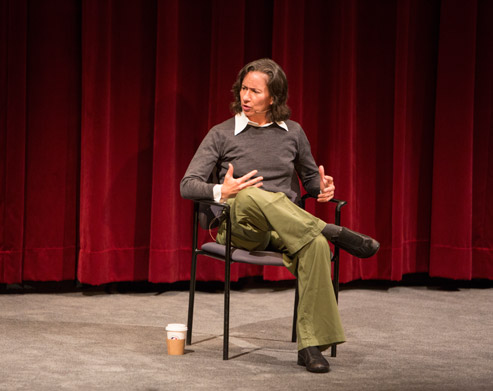Performance artist Andrea Fraser discusses her work Men on the Line, KPFK, 1972, which she brings to the Corcoran on January 29, one day after giving a Visiting Artist lecture. The performance—Fraser’s first in Washington, D.C.—re-enacts a radio program from 1972 in which four men discuss their reactions to the women’s movement. Fraser plays all four roles.
Where were you in 1972?
I was six or seven years old, living in San Mateo, California. My family had moved from Billings, Montana, to Berkeley in 1967, where my father attended the Unitarian seminary. My parents quickly got involved with the various movements that were flourishing in Northern California—the anti-war movement, the women’s movement. My mother took part in a consciousness-raising and other feminist groups. When I told my father about this performance, he sent me an essay on men’s liberation he wrote in 1971 for a journal called Progressive World.
What drew you to this material?
Emi Fontana invited me to participate in a series of performances inspired by the Woman’s Building, a center for feminist art and culture in Los Angeles. I wanted to do something about the group process that was central to the feminist movement. That interest led me to the archives of the Pacifica Radio station KPFK, which broadcast a lot of programs about feminism in the 1970s. The idea of performing this discussion by “men committed to feminism” resonated with debates about gender identity that have become central to contemporary feminism. It also represents a lost history of the men’s movement that developed alongside the women’s movement. These men reflect not only on feminism but also on masculinity with a vulnerability that remains very rare today. In my capacity as a professor of art at UCLA, I find that young women have tools for addressing gender and sexuality in their art and lives that most young men don’t have.
How did you develop the recording into a performance?
In addition to performing the dialogue, I also use clips of the original broadcast, including the opening sequence with John Lennon’s “Working Class Hero” and a conversation with the artist Judy Chicago. But performance for me is not just about the live event. It’s the entire process of creating a work. I often say that I don’t perform other people; rather, I perform relationships with other people. Researching, transcribing, editing, memorizing, internalizing, embodying are all part of that. I’ve spent a lot of time with these four men. In this case, the identification and empathy that all performers perform in taking on a role also re-performs the struggle of these men to identify and empathize with women. What one ends up with is a dense layering of gender roles and reversals.
Above: Andrea Fraser, Documentation from Performing Histories: Live Artworks Examining the Past at The Museum of Modern Art, New York. Photo © The Museum of Modern Art. Photo credit: Yi-Chun Wu.


